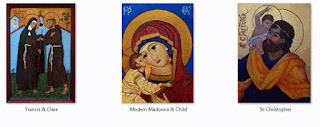Icons enjoy a special place in the contemplative tradition. The word 'icon'
comes from a Greek word meaning 'image' and traditionally referred to religious pictures, usually painted
on wooden panels, from the eastern or Byzantine Orthodox Christian tradition.
Their popularity dates from the fifth century and while an
attempt was made to abolish them during the eight and ninth centuries, it
never succeeded. Since then, they have always played an essential
part in the public and private worship. The
style is typically two-dimensional, and usually includes stylized paintings of Christ,
Mary, the Saints, or scenes from their lives.
Traditional icons are usually copies of earlier art works because the iconographer's duty was to preserve a sacred image in the same way a manuscript copier passed on a sacred text of scripture. Many icons became famous for their miracles, such as Christ of Edessa which was believed to have been written supernaturally (its popular title is 'made without hands'), or the Theotokos, an icon of The Virgin holding the Christ child. In this sense, Icons were seen to be more than simply pictures; they were 'thin places' through which the viewer could gaze into eternity. A little like the story about the Curé d'Ars, St Jean-Marie Vianney. When someone asked him, 'What did he do during the hours he spent in church before the Blessed Sacrament?' He said, 'I do nothing – other than look at Him, and He looks at me'. St Vianney experienced the power of a silent gaze for nurturing a deep spiritual friendship. As a result, he saw everything in a different light and became a channel of Divine love and light to others. People would flock to him because they found in him a reflection of God's love and forgiveness. (http://www.totus2us.com/vocation/saints/st-john-mary-vianney/).

No comments:
Post a Comment